|

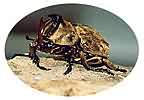 Allomyrrhina
pfeifferi Allomyrrhina
pfeifferi
Length: 25-40mm. Allomyrrhina pfeifferi is much rarer than its close relative A.
dichotoma (which is the most commonly kept rhino in Asia). A. pfeifferi
imagoes feed on the soft parts of banana, apple, orange, and other fruits.
The larvae of this species prefer a diet with mostly rotten wood. This
species of Dynastinae is one of the loudest and most enthusiastic "squeakers"
of the rhinos. It contracts its spiracles when threatened to make these
sounds. The fuzzy look of this rhino is due to numerous hairs (setae) covering
the elytra and pronotum.
 Allomyrrhina
dichotoma Allomyrrhina
dichotoma
Length: 35-90mm. This has to be my favorite species of Dynastinae. A. dichotoma is one of the most beautiful species of beetles in the world and the horn formation resembles no other. A. dichotoma has been kept by insect enthusiasts for over 30 years. This species comes from Taiwan, Japan, and China (the photo is Taiwan origin) and Males can reach nearly 4 inches (90mm). Imagoes enjoy feeding on most sugary liquids and larvae prefer to eat mostly rotten wood.
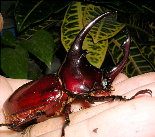 Augosoma centaurus Augosoma centaurus
Length: 40-90mm. This beautiful beetle hails from tropical Africa and is is arguably the most handsome of the African rhinos. It was first described as a species in the genus Dynastes and later moved to Augosoma. The grubs don't look like Dynastes and are unique with the exception of the related A. hippocrates. The life cylce takes two years. Though incredible and not especially demanding it's almost never seen in the hobby.
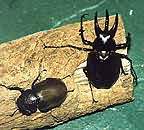 Chalcosoma
mollenkampi Chalcosoma
mollenkampi
Length: 40-110mm. C. mollenkampi is very easily distinguishable from its close relatives,
C. atlas and C. caucasus due to the horn formation which comes from the
middle of the thorax rather than the sides. Imagoes of C. mollenkampi seem
to prefer just banana slices and larvae enjoy large amounts of high protein
food along with rotten wood. If one is not careful when handling the massive
larvae they can turn their body around and give a bite which draws blood!
Length: 35-115mm. Chalcosoma atlas has certainly been one of the most wanted rhinos
of rhino beetle fanatics. The atlas beetle is very common in the wild so
and some collectors offer them at very cheap prices. I have not seen any
2nd gen or greater captive bred offered and it sadly seems that people
tend to have little luck in getting captive raised female imagoes to lay
more than a few eggs. Raising a major male like the one pictured is great
but keeping them in constant culture would be better. Like other Chalcosoma,
the L3 larvae can inflict painful bites. Pupa of the male imago in photograph
can be seen on Species Life Cycle page.
Length: 65-170mm. The Hercules beetle is nearly always the number one rhino wanted
by any child and most of us larger children. The massive horns of the male
imagoes are often longer than the body itself. Larvae consume massive quantities
of dog food or other high protein food and each larvae should be given,
at a minimum, 4 liters of space. As with the other Dynastes, adults feed
happily on slices of banana and other fruits. The C.B. male pictured is
very small at only 90mm.
 Dynastes
tityus Dynastes
tityus
Length: 30-65mm. D. tityus is one of only six species in the Genus Dynastes and
is one of the more interesting Dynastinae. Side horns on major males can
be very impressive and distinguish this species from D. hyllus and D. granti.
Larvae of D. tityus grow large fast when fed a majority of compost supplemented
by much protein and some rotten wood. Imagos feed on soft parts of fruits
in captivity and tree sap in the wild.
 Eupatorus
gracillicornis Eupatorus
gracillicornis
Length: 45-80mm. The Five-horned beetle is the boldly coloured, and one of the most extravagant of rhino imagoes. Body coloration is shiny jet-black while the elytra are coloured yellow or gold. There are four large horns on the pronotum while the largest is the cephalic horn. Larvae try to bite when handled but do not appear to be cannibalistic under reasonable conditions. Larvae are difficult to discern from their close relatives in the genus Chalcosoma. E. gracillicornis hails from Southeast Asia.
 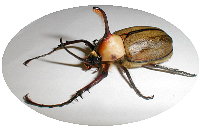 Golofa
eacus Golofa
eacus
Length: 25-60mm. Golofa eacus larvae do well in close proximity with a few L3 larvae kept per liter. As with other larvae the food necessary for major imagoes includes a varied diet of wood, compost, leaves, etc. Imagoes eat the usual fare of soft fruits and sugary liquids. They eat and begin to breed three to four weeks after emergence. This male is my best so far at 57mm. The handsome pair of imagoes pictured on the right were underfed as L1 & L2 and are small. 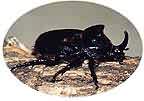 Heterogomphus
chevrolati Heterogomphus
chevrolati
Length: 20-50mm. Heterogomphus chevrolati is a very large rhino whose body
size can rival a medium size atlas. This beetle comes from Costa Rica and
neighboring countries in Central and South America. Imagos are not as voracious
feeders as most dynastids but will accept some banana and apple slices.
Fortunately for handling purposes this species does not have the large
sharp claws of most rhinos.
Length: 40-45mm. This relative of the Triceratops beetle is not in culture.
It is shiny red-brown and nearly as large. I was so excited to acquire
a male and female imago from Peurto Rico. I set them up in perfect substrate
but the next day the male ate the female. I should have fed the adults
for a few weeks before introducing them together. I was very lucky to acquire
a pair and will probably never see them again.
Length: 40-120mm. Despite the erroneous claims that G. goliathus, T. giganteus, etc.
are the most massive of the beetle imagos M. actaeon can actually prove
that it is the true winner. Despite the large size of adult and larvae
this is actually a very gentle species and larvae never seem to cannibalize.
The only unfortunate characteristic of this species is the tendency to
take 3 years to become an imago.
Length: 40-110mm. M. mars is another example of the gigantic rhinoceros beetles in
the genus Megasoma (otherwise known as elephant beetles). They grow nearly
as large and also customarily need three years for the life cycle. Females
are very shiny and deep black.
Length: 20-55mm. This widespread rhino beetle hails from Asia and can cause
problems with palm trees. In captivity the larvae feed on rotten compost
and wood and will not feed on any but the most rotted wood. Female imagoes
are very difficult to distinguish from males since both sexes have horns,
but the males do not have such large amounts of sensory hairs at the end
of the abdomen and the bottom of the pygidium points towards the anterior
rather than the posterior.
Length: 35-50mm. The Triceratops beetle can be caught throughout North America
but is seldom kept by people there as it is uncommonly found. Imagoes live
for years, are carnivorous and feed on worms, crickets, stick insects,
etc., other beetles and each other. Male and female imagoes and larvae
of this species look identical. Larvae grow with incredible speed and vibrate
when held (hatching to L3 takes less than 30 days! Wow!) Larvae do not
eat one another although hungry imagoes often eat them.
Length: 20-35mm. This This small species can be found in massive numbers in season across its range. Despite its numbers in nature it's incredibly difficult to get imagoes to deposit ova and the larvae require extraordinary attention to mature successfully. The cycle is one year in captivity. Imagoes rarely live more than a few months. This rhinoceros beetle is found across the southwestern United States and Mexico. A similar species lives in the central and eastern USA.
Length: 45-70mm. Subspecies of the Fighting Beetle are found throughout Asia and the Indo/Pacific. This species is regarded as the most powerful of the fighting beetles. The splendid male imago pictured is a captive-reared specimen which has just emerged from its pupa. The line is probably originally from Borneo. Most subspecies look very similar with only minor horn structure differences. As with most rhinos, horn structure varies greatly even in siblings. These are the easiest rhino to rear which makes them a favorite. Adults make loud squeaking noises when picked up. |